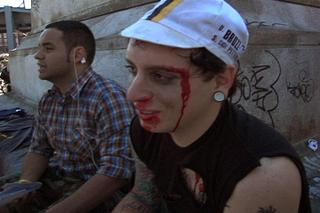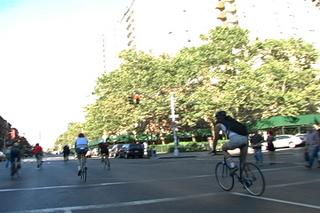the deviant thrill of the scatter
More updates to follow. Please send me pictures.

 Then get together with a bunch of friends and load all your bikes in a pickup truck or minivan.
Then get together with a bunch of friends and load all your bikes in a pickup truck or minivan. This is a great way to get more people to go out of town.
This is a great way to get more people to go out of town. Then find some cheap accomodations near the action. Hotels can be a cheap way to go, especially if you split up the rooms and some places are even bike friendly.
Then find some cheap accomodations near the action. Hotels can be a cheap way to go, especially if you split up the rooms and some places are even bike friendly. Then get to the rally spot for the start of the ride.
Then get to the rally spot for the start of the ride.


 Sometimes the cops will leave you alone so its best to ride on into the night with your new found friends.
Sometimes the cops will leave you alone so its best to ride on into the night with your new found friends.

 Awesome.
Awesome.
 Bikes at the Saturday March
Bikes at the Saturday March Critical Cop Mass. DC is an interesting place to demonstrate. They have 7 divisions of bicycle cops. The parks department wears riot gear, and of course you have the Secret Service, FBI, CIA, Metro Police, Special Ops, and just about every state, federal and local law enforcement you could imagine.
Critical Cop Mass. DC is an interesting place to demonstrate. They have 7 divisions of bicycle cops. The parks department wears riot gear, and of course you have the Secret Service, FBI, CIA, Metro Police, Special Ops, and just about every state, federal and local law enforcement you could imagine.  It's good to know we have lots of security on hand, encase some crazy bike riders try to raise up their bikes or something. Thanks to Time's up for the pictures.
It's good to know we have lots of security on hand, encase some crazy bike riders try to raise up their bikes or something. Thanks to Time's up for the pictures.







 China celebrates world car free day
China celebrates world car free day







 Lowrider, get a little higher!!
Lowrider, get a little higher!! Nice Meat!!
Nice Meat!! Then it was time to go back to Brooklyn and we wanted to take the 59th Street bridge. I really hate using 2nd Ave cause of all the traffic. So we went across town over to the FDR and went across a footbridge. There is a path along the East River and then we took the bridge to Randalls Island.
Then it was time to go back to Brooklyn and we wanted to take the 59th Street bridge. I really hate using 2nd Ave cause of all the traffic. So we went across town over to the FDR and went across a footbridge. There is a path along the East River and then we took the bridge to Randalls Island. This is a really nice ride. Then it was over the Triborough and into Queens. Here we saw the bikes on poles at Socrates Sculture Garden.
This is a really nice ride. Then it was over the Triborough and into Queens. Here we saw the bikes on poles at Socrates Sculture Garden. 
 Photo of the artists David Shapiro, with the bicycles he found almost beyond redemption.
Photo of the artists David Shapiro, with the bicycles he found almost beyond redemption.


 The crowd gathers at Union Square South to begin the second ride for Norman of the day, around 6:30pm
The crowd gathers at Union Square South to begin the second ride for Norman of the day, around 6:30pm This was a cool bike made for 2 people to ride side by side.
This was a cool bike made for 2 people to ride side by side.
 Norman addresses the crowd.
Norman addresses the crowd. Fix gears for Norman
Fix gears for Norman

 Arriving at campaign headquarters, we ate good food, drank beer and watched Norman loose. Sad. Oh well, he's still our lawyer.
Arriving at campaign headquarters, we ate good food, drank beer and watched Norman loose. Sad. Oh well, he's still our lawyer.


 Jason all bloody, fake blood.
Jason all bloody, fake blood.  riders waiting for the start.
riders waiting for the start. I tried to do my best Junior impression, the obnoxious host of the movie. There is plans in the works to make a short video about this race.
I tried to do my best Junior impression, the obnoxious host of the movie. There is plans in the works to make a short video about this race. there was a doctor on hand with his nurse copilot.
there was a doctor on hand with his nurse copilot. This messenger from LA was a bit out of his teritory but he picked up a 15 year old kid to show him his way around the city. This was by far the largest age gap of team members. The kid was also the youngest to compete in the alley cat. Turns out his father was a cycle messenger in the 70's and would take him to critical mass when he was 7.
This messenger from LA was a bit out of his teritory but he picked up a 15 year old kid to show him his way around the city. This was by far the largest age gap of team members. The kid was also the youngest to compete in the alley cat. Turns out his father was a cycle messenger in the 70's and would take him to critical mass when he was 7.  The youngest rider. Everyone gathered at the Brooklyn side of the Williamsburg bridge, in teams of 2 and in various costumes. Here they were given a t-shirt and a manifest with a list of the checkpoints which they could do in what ever order they saw fit.
The youngest rider. Everyone gathered at the Brooklyn side of the Williamsburg bridge, in teams of 2 and in various costumes. Here they were given a t-shirt and a manifest with a list of the checkpoints which they could do in what ever order they saw fit. registration
registration

 checking the map
checking the map team Fans of Frankenstein, hoping that some vigins will sacrifice themselves to them for points.
team Fans of Frankenstein, hoping that some vigins will sacrifice themselves to them for points. Team teen wolf...who did well in the race and finished in the top 10. The tall guy didn't slow his teammate down, even though he flew over the hood of a taxi somewhere in midtown. The race took off around 4:30pm and many riders took the car path of the Williamsburg bridge for the fastest possible route into the first check point at 28th and 1st. Ave. Squid, keeping true to the spirit of the film had a female team mate and they leaped out in front pack, up the steep part of the bridge.
Team teen wolf...who did well in the race and finished in the top 10. The tall guy didn't slow his teammate down, even though he flew over the hood of a taxi somewhere in midtown. The race took off around 4:30pm and many riders took the car path of the Williamsburg bridge for the fastest possible route into the first check point at 28th and 1st. Ave. Squid, keeping true to the spirit of the film had a female team mate and they leaped out in front pack, up the steep part of the bridge. Squid and Uri
Squid and Uri



 Squid's partner cruisin up 1st Ave.
Squid's partner cruisin up 1st Ave. After checkpoints in Manhattan, the racers crossed the 59th bridge and had to answer a triva question at the Long Island City side.
After checkpoints in Manhattan, the racers crossed the 59th bridge and had to answer a triva question at the Long Island City side. Carlos, a team puma racer, was one of the winners overall, despite losing his partner. He completed the ride in about 50 minutes which is pretty damn fast to go from Brooklyn, through Manhattan and back into Queens. The official race results will be posted. It was a good day at the races. No old ladies were killed. In a side note, while checking the internet movie data base on deathrace 2000, it looks like they are in development of a 2006 remake. I know Sly Stalone is available.
Carlos, a team puma racer, was one of the winners overall, despite losing his partner. He completed the ride in about 50 minutes which is pretty damn fast to go from Brooklyn, through Manhattan and back into Queens. The official race results will be posted. It was a good day at the races. No old ladies were killed. In a side note, while checking the internet movie data base on deathrace 2000, it looks like they are in development of a 2006 remake. I know Sly Stalone is available.